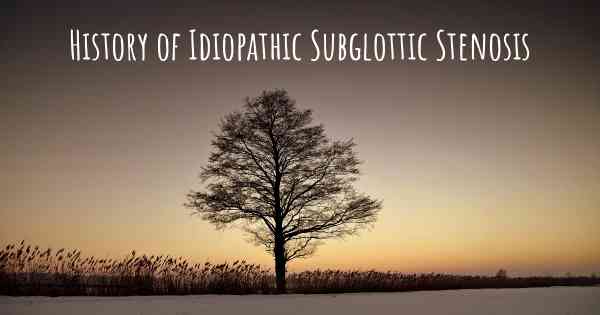What is the history of Idiopathic Subglottic Stenosis?
When was Idiopathic Subglottic Stenosis discovered? What is the story of this discovery? Was it coincidence or not?

Idiopathic Subglottic Stenosis (ISS) is a rare condition characterized by the narrowing of the subglottic region of the larynx, which can lead to breathing difficulties. The term "idiopathic" refers to the fact that the cause of this condition is unknown. ISS was first described in medical literature in the early 20th century, and since then, researchers have made significant progress in understanding and managing this condition.
The history of ISS begins with the recognition of its symptoms and the development of diagnostic techniques. In the early 1900s, physicians started noticing patients presenting with symptoms such as hoarseness, stridor (a high-pitched breathing sound), and difficulty breathing. However, it wasn't until the 1920s that ISS was officially recognized as a distinct clinical entity.
During the mid-20th century, advancements in medical imaging techniques, such as bronchoscopy and laryngoscopy, allowed for a more accurate diagnosis of ISS. These procedures involve inserting a thin, flexible tube with a camera into the airway to visualize the subglottic region. This enabled physicians to identify the characteristic narrowing and scarring of the subglottic area, confirming the presence of ISS.
As the understanding of ISS improved, researchers began investigating potential causes and risk factors. However, despite extensive research, no definitive cause has been identified. This lack of a known cause is what distinguishes ISS as an idiopathic condition. Some theories suggest that ISS may be an autoimmune disorder, while others propose a genetic predisposition or an abnormal response to injury or inflammation.
Over the years, various treatment approaches have been explored to manage ISS. Initially, surgical interventions such as dilation and tracheostomy were commonly used. Dilation involves stretching the narrowed area using specialized instruments, while tracheostomy involves creating an opening in the windpipe to bypass the narrowed region. While these procedures provided temporary relief, they often required repeated interventions and had associated risks and complications.
In recent decades, endoscopic techniques have emerged as the preferred treatment for ISS. Endoscopic procedures involve using specialized instruments to remove or reshape the scar tissue causing the narrowing. This approach offers several advantages, including shorter recovery times, reduced risk of complications, and improved long-term outcomes. Endoscopic techniques can be performed using lasers, microdebriders, or other instruments, depending on the severity and location of the stenosis.
Despite the advancements in treatment, ISS remains a challenging condition to manage. The exact prevalence of ISS is unknown, but it is considered a rare disorder. It primarily affects middle-aged women, although cases have been reported in men and children as well. The symptoms of ISS can vary in severity, ranging from mild breathing difficulties to life-threatening airway obstruction.
Research efforts continue to focus on understanding the underlying mechanisms of ISS and developing more effective treatments. Ongoing studies aim to identify potential genetic markers, explore the role of inflammation and immune dysfunction, and investigate novel therapeutic approaches.
In conclusion, Idiopathic Subglottic Stenosis is a rare condition characterized by the narrowing of the subglottic region of the larynx. Despite being recognized in the early 20th century, the exact cause of ISS remains unknown. Advances in diagnostic techniques and treatment approaches have significantly improved the management of this condition. However, further research is needed to unravel the underlying mechanisms and develop more targeted therapies.








